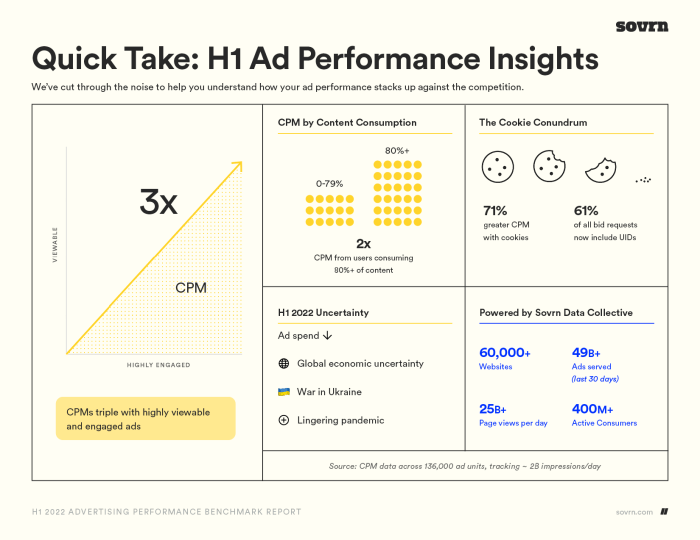Using Data to Improve Ad Performance takes center stage as we dive into the world of optimizing ad effectiveness with the power of data analytics. Get ready to supercharge your ad campaigns!
Let’s explore the key metrics, popular data analytics tools, A/B testing strategies, and targeting tactics that can elevate your ad performance to new heights.
Importance of Data in Ad Performance: Using Data To Improve Ad Performance
Data is a critical component in optimizing ad performance as it provides valuable insights into audience behavior, preferences, and engagement levels. By analyzing data, advertisers can make informed decisions to enhance the effectiveness of their ads and maximize their return on investment.
Key Metrics for Tracking Ad Performance
- Click-through Rate (CTR): This metric measures the percentage of users who click on an ad after viewing it. A high CTR indicates that the ad is resonating with the target audience.
- Conversion Rate: The conversion rate tracks the percentage of users who take a desired action after clicking on an ad, such as making a purchase or signing up for a newsletter.
- Return on Ad Spend (ROAS): ROAS calculates the revenue generated for every dollar spent on advertising. It helps advertisers gauge the profitability of their ad campaigns.
- Impressions: Impressions indicate the number of times an ad is displayed to users. Monitoring impressions can help advertisers assess the reach of their ads.
Impact of Data-Driven Decisions on Ad Effectiveness
Data-driven decisions have a significant impact on overall ad effectiveness by enabling advertisers to tailor their campaigns to the specific needs and preferences of their target audience. By leveraging data insights, advertisers can create more relevant and personalized ads, leading to higher engagement and conversion rates. Furthermore, data-driven decisions help optimize ad placement, targeting, and messaging to maximize performance and achieve campaign objectives.
Utilizing Data Analytics Tools

When it comes to analyzing ad performance, data analytics tools play a crucial role in providing valuable insights and metrics that can help in making informed decisions. These tools allow marketers to track, measure, and optimize their ad campaigns effectively.
Popular Data Analytics Tools
- Google Analytics: One of the most widely used tools for tracking website traffic, user behavior, and conversion rates. It provides detailed data on ad performance and audience demographics.
- Facebook Analytics: Specifically designed for analyzing ad performance on the Facebook platform, it offers insights into audience engagement, ad reach, and conversion rates.
- Adobe Analytics: A comprehensive tool that allows for in-depth analysis of customer interactions across multiple channels, providing a holistic view of ad performance.
Benefits of Using Data Analytics Tools
- Accurate Measurement: Data analytics tools help in accurately tracking key metrics such as click-through rates, conversion rates, and ROI, providing a clear picture of ad performance.
- Optimization Opportunities: By analyzing data trends and patterns, marketers can identify areas for improvement and optimize their ad campaigns for better results.
- Targeted Marketing: Data analytics tools enable marketers to segment their audience based on behavior and preferences, allowing for more targeted and personalized ad campaigns.
Implementing A/B Testing for Ad Creatives
When it comes to improving ad performance, one effective strategy is implementing A/B testing for ad creatives. A/B testing involves creating two versions of an ad (A and B) with one differing element, such as the headline, image, or call-to-action, to see which performs better.
Best Practices for Setting Up A/B Tests, Using Data to Improve Ad Performance
- Clearly define your goals: Before starting an A/B test, make sure you have a clear understanding of what you want to achieve, whether it’s increasing click-through rates, conversions, or engagement.
- Test one element at a time: To accurately determine the impact of a change, only test one element at a time. This could be the ad copy, visuals, or targeting parameters.
- Use a large enough sample size: Ensure that your test reaches a significant number of users to get reliable results. A small sample size may not provide accurate insights.
- Monitor and analyze results: Track the performance of both versions of the ad closely and analyze the data to determine which version is more effective. Look at metrics like click-through rates, conversion rates, and engagement levels.
Analyzing A/B Test Results to Optimize Ad Campaigns
By analyzing A/B test results, advertisers can gain valuable insights into what resonates with their target audience and make data-driven decisions to optimize future ad campaigns.
- Identify trends: Look for patterns in the data to identify what elements are driving better performance. This could help you understand what message or creative style appeals most to your audience.
- Iterate and refine: Use the learnings from A/B tests to continuously refine your ad creatives and improve their effectiveness over time. Experiment with different variations to find the winning formula.
- Implement changes: Once you have identified the winning ad creative, implement those changes across your campaigns to maximize performance and achieve your advertising goals.
Targeting and Segmentation Strategies

Using data to create targeted ad campaigns is crucial in reaching the right audience with the right message at the right time. By analyzing data on demographics, interests, behavior, and more, marketers can tailor their ads to specific segments for better engagement and conversion rates.
Effective Segmentation Strategies
- Geographic Segmentation: Targeting ads based on location data to reach customers in specific regions or cities.
- Behavioral Segmentation: Creating ads based on user behavior such as past purchases, website visits, or search history.
- Psychographic Segmentation: Segmenting audiences based on personality traits, values, attitudes, and interests.
- Demographic Segmentation: Targeting ads based on age, gender, income, education level, and other demographic factors.
Importance of Personalized Messaging
Personalized messaging plays a key role in improving ad performance as it helps create a connection with the audience on a more personal level. By using data to personalize ad copy, visuals, and offers, marketers can increase relevance and engagement, leading to higher click-through rates and conversions.
